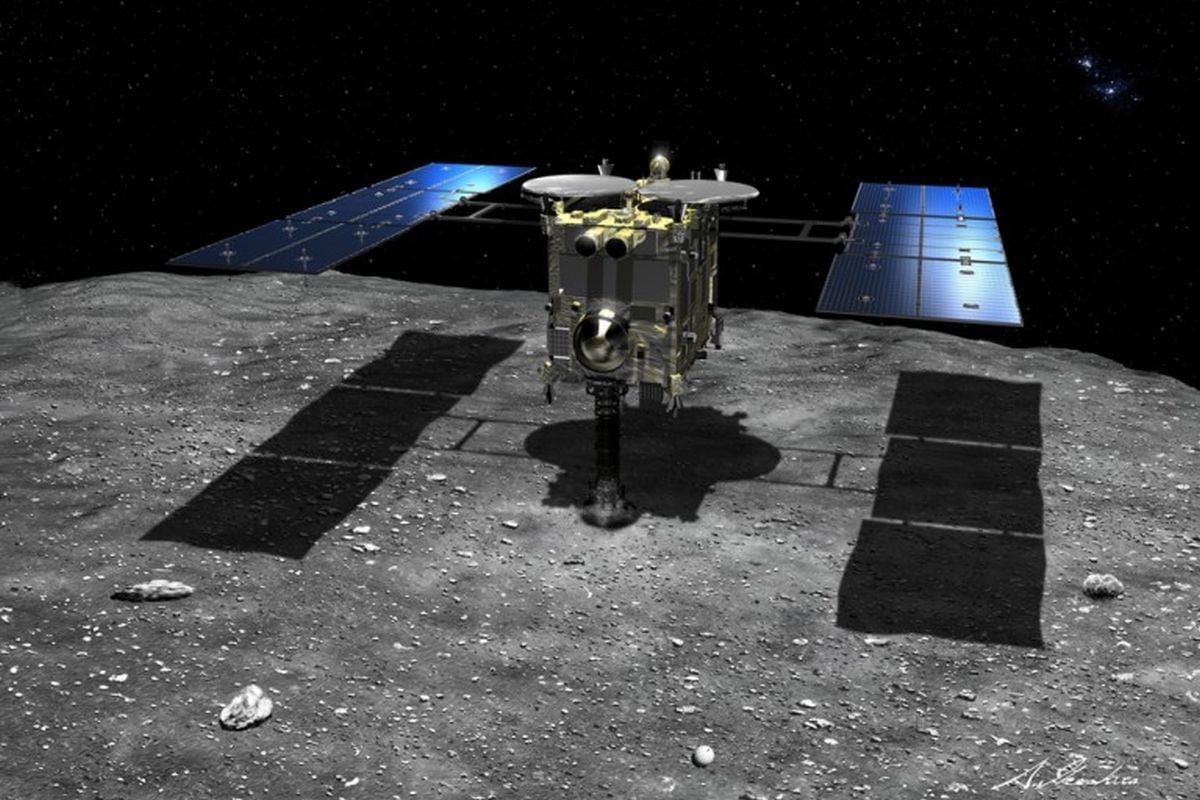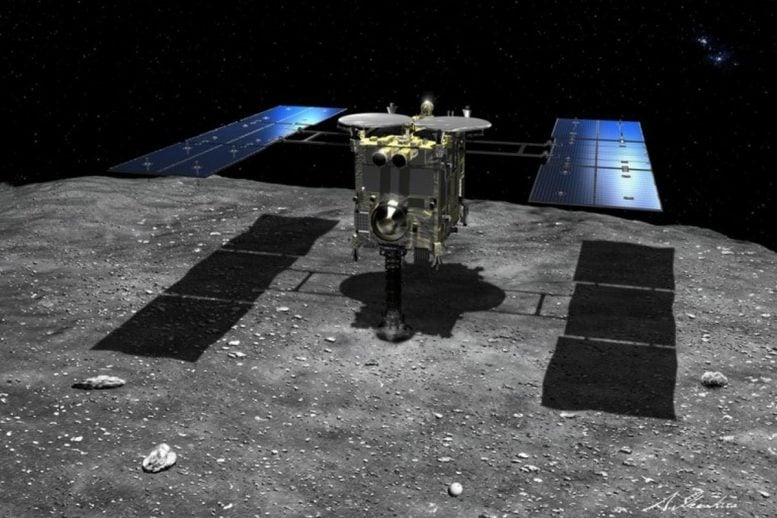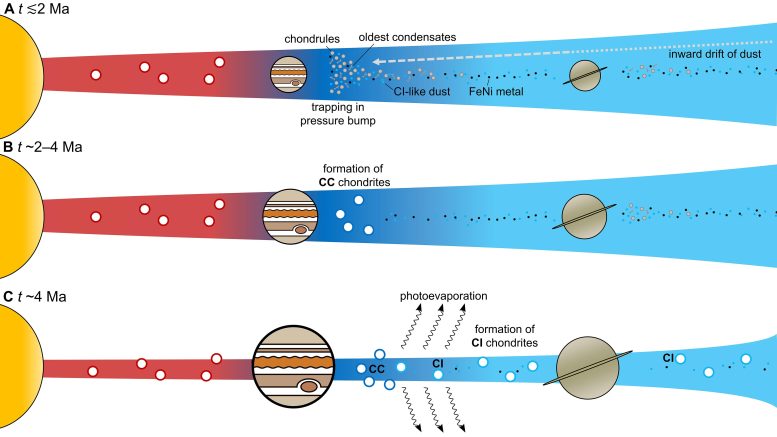

Samples from asteroid Ryugu have once again surprised scientists, challenging previous ideas about how carbon-rich asteroids form.
New research published in Science Advances suggests that Ryugu may have formed near Jupiter, rather than beyond Saturn’s orbit as earlier studies indicated. Four years ago, Japan’s Hayabusa 2 mission brought back samples of Ryugu to Earth. Researchers from the Max Planck Institute for Solar System Research (MPS) in Germany compared the types of nickel found in these samples to those in typical carbon-rich meteorites. Their findings suggest a new possibility: different carbon-rich asteroids may have formed in the same region near Jupiter, though through varying processes and about two million years apart.
Global Journey of Ryugu Samples
Since the Hayabusa 2 probe delivered Ryugu’s samples to Earth in December 2020, the material has been thoroughly analyzed. The tiny, jet-black grains were initially examined in Japan and then sent to research facilities worldwide. There, scientists measured, weighed, and chemically analyzed the samples, subjecting them to infrared, X-ray, and synchrotron radiation tests. At the MPS, researchers focused on the ratios of metal isotopes, including nickel. These isotopic studies, which involve examining elements with differing neutron counts, help scientists pinpoint where in the Solar System Ryugu likely formed.
Ryugu’s Journey Through the Solar System
Ryugu is a near-Earth asteroid: Its orbit around the Sun crosses that of Earth (without risk of collision). However, researchers assume that, like other near-Earth asteroids, Ryugu is not native to the inner Solar System, but traveled there from the asteroid belt located between the orbits of Mars and Jupiter. The actual birthplaces of the asteroid belt population are probably even further away from the Sun, outside the orbit of Jupiter.
Ryugu’s “family relations” can help shed light on its origin and further evolution. To what degree does Ryugu resemble the representatives of well-known classes of meteorites? These are fragments of asteroids that have made their way from space to Earth.

Investigations in recent years have yielded a surprise: Ryugu fits into the large crowd of carbon-rich meteorites, the carbonaceous chondrites, as expected. However, detailed studies of its composition assign it to a rare group: the so-called CI chondrites. These are also known as Ivuna-type chondrites, named after the Tanzanian location where their best-known representative was found. In addition to the Ivuna chondrite itself, only eight others of these exotic specimens have been discovered to date. As their chemical composition is similar to that of the Sun, they are considered to be particularly pristine material that was formed at the outermost edge of the Solar System.
“So far, we had assumed that Ryugu’s place of origin is also outside Saturn’s orbit,” explains MPS scientist Dr. Timo Hopp, co-author of the current study, who has already led earlier investigations into Ryugu’s isotopic composition.
The latest analyses by the Göttingen scientists now paint a different picture. For the first time, the team investigated the ratios of nickel isotopes in four samples of the asteroid Ryugu and six samples of carbonaceous chondrites. The results confirm the close relationship between Ryugu and the CI chondrites. However, the idea of a common birthplace at the edge of the Solar System is no longer compelling.
A Revised Understanding of Cosmic Ingredients
What had happened? Until now, researchers had understood carbonaceous chondrites as mixtures of three “ingredients” that can even be seen with the naked eye in cross-sections. Embedded in fine-grained rock, round, millimeter-sized inclusions as well as smaller, irregularly shaped inclusions are densely packed together. The irregular inclusions are the first material to have condensed into solid clumps in the hot gas disk that once orbited the Sun. The round silicate-rich chondrules formed later.
Until now, researchers have attributed differences in the isotopic composition between CI chondrites and other groups of carbonaceous chondrites to different mixing ratios of these three ingredients. CI chondrites, for example, consist predominantly of fine-grained rock, while their siblings are significantly richer in inclusions. However, as the team describes in the current publication, the results of the nickel measurements do not fit into this scheme.
The researchers’ calculations now show that their measurements can only be explained by a fourth ingredient: tiny iron-nickel grains, which must also have accumulated during the formation of the asteroids. In the case of Ryugu and the CI chondrites, this process must have been particularly efficient. “Completely different processes must have been at work in the formation of Ryugu and the CI chondrites on the one hand and the other groups of carbonaceous chondrites on the other,” says Fridolin Spitzer from the MPS, first author of the new study, summarizing the basic idea.
Surprising Discoveries in Asteroid Research
According to the researchers, the first carbonaceous chondrites began to form around two million years after the formation of the Solar System. Attracted by the gravitational force of the still-young Sun, dust and the first solid clumps made their way from the outer edge of the gas and dust disk into the inner Solar System, but encountered an obstacle along the way: the newly forming Jupiter.
Outside its orbit, the heavier and larger clumps in particular accumulated – and thus grew into carbonaceous chondrites with their many inclusions. Towards the end of this development, after around two million years, another process gained the upper hand: under the influence of the Sun, the original gas gradually evaporated outside Jupiter’s orbit leading to the accumulation of primarily dust and iron-nickel grains. This led to the birth of the CI chondrites.
“The results surprised us very much. We had to completely rethink – not only with regard to Ryugu, but also with regard to the entire group of CI chondrites,” says Dr. Christoph Burkhard from the MPS. The CI chondrites no longer appear as distant, somewhat exotic relatives of the other carbonaceous chondrites from the outermost edge of the Solar System, but rather as younger siblings that may have formed in the same region, but through a different process and later.
“The current study shows how crucial laboratory investigations can be in deciphering the formation history of our Solar System,” says Prof. Dr. Thorsten Kleine, Director of the Department of Planetary Sciences at the MPS and co-author of the study.
Reference: “The Ni isotopic composition of Ryugu reveals a common accretion region for carbonaceous chondrites” by Fridolin Spitzer, Thorsten Kleine, Christoph Burkhardt, Timo Hopp, Tetsuya Yokoyama, Yoshinari Abe, Jérôme Aléon, Conel M. O’D Alexander, Sachiko Amari, Yuri Amelin, Ken-ichi Bajo, Martin Bizzarro, Audrey Bouvier, Richard W. Carlson, Marc Chaussidon, Byeon-Gak Choi, Nicolas Dauphas, Andrew M. Davis, Tommaso Di Rocco, Wataru Fujiya, Ryota Fukai, Ikshu Gautam, Makiko K. Haba, Yuki Hibiya, Hiroshi Hidaka, Hisashi Homma, Peter Hoppe, Gary R. Huss, Kiyohiro Ichida, Tsuyoshi Iizuka, Trevor R. Ireland, Akira Ishikawa, Shoichi Itoh, Noriyuki Kawasaki, Noriko T. Kita, Kouki Kitajima, Shintaro Komatani, Alexander N. Krot, Ming-Chang Liu, Yuki Masuda, Mayu Morita, Fréderic Moynier, Kazuko Motomura, Izumi Nakai, Kazuhide Nagashima, Ann Nguyen, Larry Nittler, Morihiko Onose, Andreas Pack, Changkun Park, Laurette Piani, Liping Qin, Sara S. Russell, Naoya Sakamoto, Maria Schönbächler, Lauren Tafla, Haolan Tang, Kentaro Terada, Yasuko Terada, Tomohiro Usui, Sohei Wada, Meenakshi Wadhwa, Richard J. Walker, Katsuyuki Yamashita, Qing-Zhu Yin, Shigekazu Yoneda, Edward D. Young, Hiroharu Yui, Ai-Cheng Zhang, Tomoki Nakamura, Hiroshi Naraoka, Takaaki Noguchi, Ryuji Okazaki, Kanako Sakamoto, Hikaru Yabuta, Masanao Abe, Akiko Miyazaki, Aiko Nakato, Masahiro Nishimura, Tatsuaki Okada, Toru Yada, Kasumi Yogata, Satoru Nakazawa, Takanao Saiki, Satoshi Tanaka, Fuyuto Terui, Yuichi Tsuda, Sei-ichiro Watanabe, Makoto Yoshikawa, Shogo Tachibana and Hisayoshi Yurimoto, 27 September 2024, Science Advances.
DOI: 10.1126/sciadv.adp2426